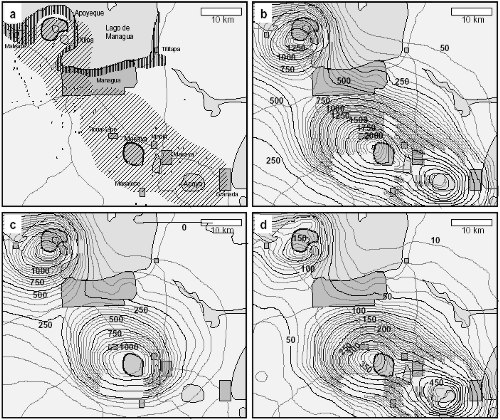 Web Content Anzeige Web Content Anzeige
Volcanic HazardsHazard map for highly explosive eruptionsIsopach data were compiled into maps of the cumulative thickness distribution of tephra from highly explosive eruptions for the area around Managua. About 2 million people (roughly 40% of Nicaraguaâ€TMs population) live in the greater Managua area, bracketed between the Chiltepe Volcanic Complex to the north and the Masaya Caldera to the south, the two recently most active volcanoes in terms of plinian-magnitude eruptions. The Managua city area was covered by a total thickness of 2-6 m from Unicit to Chiltepe Pumice eruptions (Fig. 1b). This area was affected by 4 eruptions during the interval c. 45,000 to 25,000 BP, followed by a 15,000 year period when no large eruptions affected the area. During the past 10,000 years, however, 7 large magnitude eruptions covered the city area with a total tephra thickness of 1-4 m (Fig. 1c), giving an average recurrence period of 1400 years with the highest risk in the NW sector of the city. Dividing total accumulated thickness by number of eruptions represented at each locality yields the average expected fallout thickness distribution in Fig. 1d. During the small 1992 Cerro Negro eruption, <10-cm-thick ash load caused abundant roof collapses and fatalities in the city of Leon since buildings are mostly not designed to withstand significant loading. Fig. 1d suggests that large areas in west-central Nicaragua would potentially suffer extensive building collapse during a future plinian eruption. Eruptions producing pyroclastic surges like those that formed the Masaya Tuff and most of the Xiloa Tephra would even have much greater destructive potential causing complete devastation in the areas outlined in Fig. 1a. The Chiltepe Volcanic Complex seems the most likely site of a future highly explosive eruption considering its past record of high eruption frequency.
Fig. 1: Assessment of hazards resulting from highly explosive eruptions in the larger Managua area. (a) Localities studied (dots). Areas of total devastation by pyroclastic density currents (diagonal hatching), and by volcanogenic tsunamis along the shore of Lago de Managua (vertical hatching) are shown as they occurred in the past. (b) Total cumulative thickness of eruption products from Unicit to Chiltepe Pumice (c. 45,000 years time span). (c) Total cumulative thickness from Lower Apoyeque to Chiltepe eruptions (past c. 10,000 years). (d) Average thickness of fallout tephra from past eruptions. Map (c) emphasizes how the Managua area is bracketed between the two recently most active volcanoes in terms of highly explosive eruptions, the Chiltepe Volcanic Complex to the north and the Masaya Caldera to the south. |
 Events Events
Kieler Wissenschaftler fühlen den 'Puls der Erde' Wie funktioniert die Recyclingmaschine der Erde?Nach elf Jahren endet der Kieler Sonderforschungsbereich 574 zu Subduktionszonen Final colloquium of SFB 574 Teilprojekt ÖffentlichkeitsarbeitMEERESFORSCHUNG FÜR MICH UND DICH |
|
©SFB574 // Wischhofstrasse 1-3 // D-24148 Kiel // T. +49 (0)431 600 1413 // elange [AT] geomar.de






